Missouri’s woodlands resonate with the rhythmic tap-tap-tap of eight enchanting woodpecker species, each contributing to the state’s rich avian diversity.
From the vibrant Pileated Woodpecker to the diminutive Downy Woodpecker, these feathered artisans play a vital role in Missouri’s ecosystems.
Their distinctive drumming echoes through the forests and signifies their role as both predators and ecological architects. As integral components of the local birdlife, woodpeckers help control insect populations and shape the landscapes they inhabit.
Exploring the nuances of each species, from the striking Northern Flicker to the elusive Red-headed Woodpecker, offers a glimpse into Missouri’s diverse habitats and the captivating world of these industrious and charismatic birds.
In this exploration, we unravel the stories behind each woodpecker’s enchanting presence, celebrating their significance in Missouri’s natural tapestry.
8 Woodpeckers of Missouri
Enter the lively world of Missouri’s woodlands, where the rhythmic drumming of eight woodpecker species creates a captivating symphony.
From the majestic Pileated Woodpecker to the agile Downy Woodpecker, discover the enchanting presence of these feathered craftsmen shaping the state’s ecosystems.
1. Pileated Woodpecker
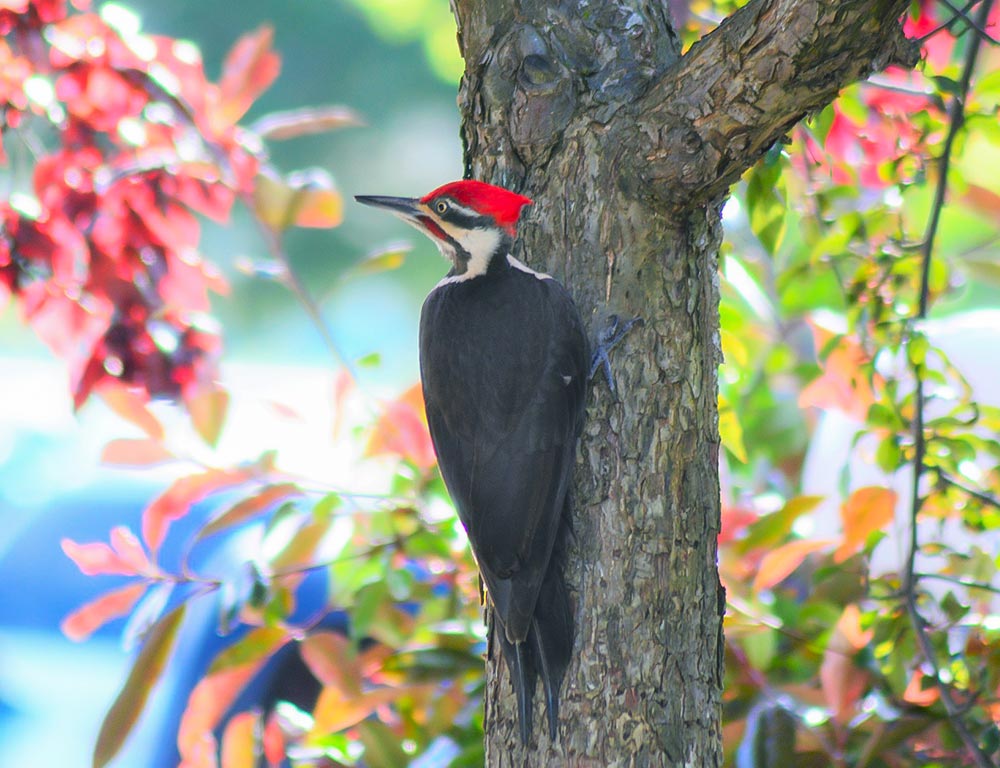
- Scientific Name: Dryocopus pileatus
- Population: Stable; common throughout its range
- Life Span: Up to 10 years in the wild
- Size: 16-19 inches in length
- Weight: Approximately 8-12 ounces
- Food: Mainly insects, supplemented by fruits and nuts
- Status: Least Concern (population stable)
With its striking red crest and large size, the Pileated Woodpecker is an iconic species in Missouri’s woodlands. These skilled excavators carve rectangular holes in trees, seeking insects such as carpenter ants and beetle larvae.
Their powerful drumming and distinctive calls echo through the forest, signaling their presence. Pileated Woodpeckers are adapted for climbing and navigating trees, utilizing their strong bills and zygodactyl feet.
Their feeding habits contribute to forest health by controlling insect populations. Despite their large size, they are agile flyers, and their presence is indicative of mature and healthy forests.
Conservation efforts focus on maintaining suitable habitats, including large tracts of undisturbed woodlands, ensuring the continued success of these charismatic woodpeckers in Missouri.
2. Red-headed Woodpecker
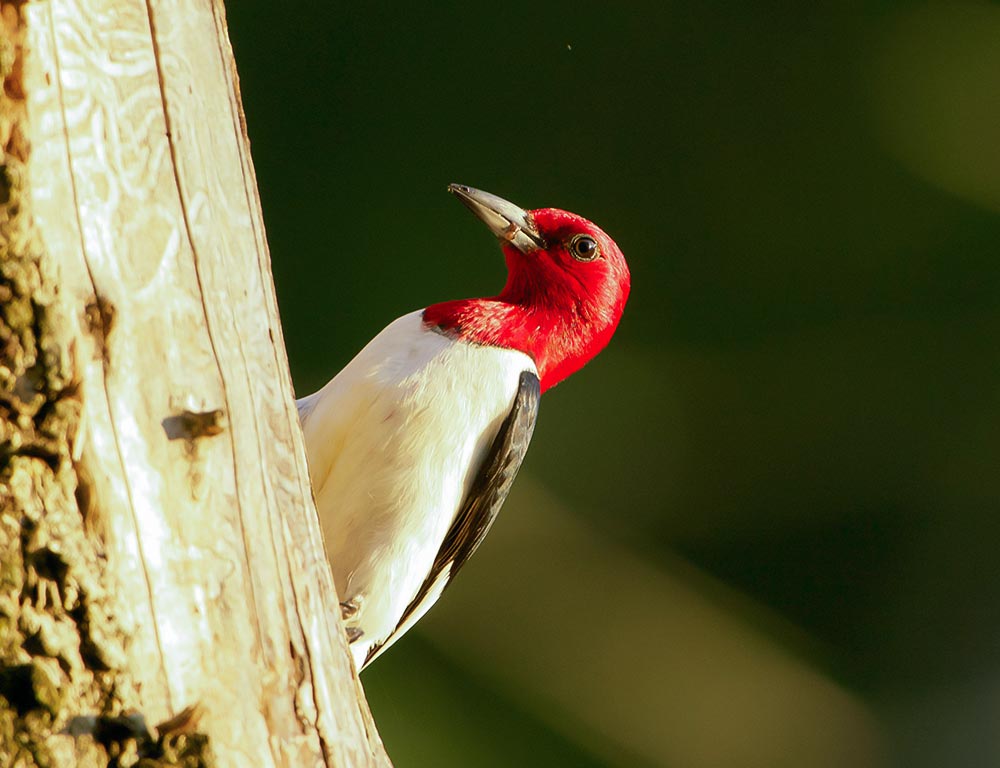
- Scientific Name: Melanerpes erythrocephalus
- Population: Declining due to habitat loss
- Life Span: Up to 9 years in the wild
- Size: 7.5-9.1 inches in length
- Weight: Approximately 2-3 ounces
- Food: Insects, seeds, nuts, and occasionally small vertebrates
- Status: Near Threatened (population decreasing)
The Red-headed Woodpecker, distinguished by its vibrant plumage and entirely red head, faces habitat challenges in Missouri.
Once common, their populations have declined due to habitat loss, primarily the reduction of dead trees for nesting sites. Red-headed Woodpeckers display agile flight patterns and forage for insects, seeds, and nuts.
Known for their unique habit of catching insects in mid-air, they also store food by impaling it on tree bark or hiding it in crevices. Conservation efforts aim to create and preserve suitable habitats, including open woodlands with ample dead trees for nesting.
Maintaining snags (standing dead trees) is crucial for their survival, as it provides essential nesting sites and contributes to the overall biodiversity of Missouri’s ecosystems.
3. Downy Woodpecker
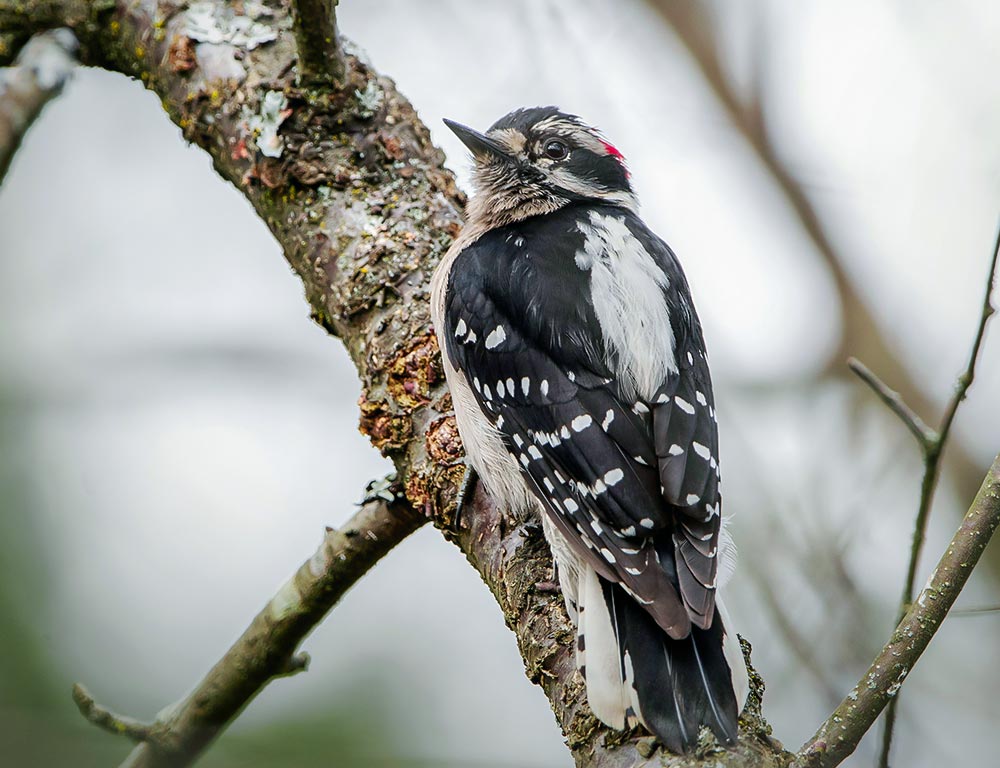
- Scientific Name: Picoides pubescens
- Population: Abundant and widespread
- Life Span: Up to 4-6 years in the wild
- Size: 5.5-7.1 inches in length
- Weight: Approximately 0.7-1.0 ounces
- Food: Insects, seeds, and berries
- Status: Least Concern (population stable)
The Downy Woodpecker, the smallest woodpecker in North America, is a common and adaptable species in Missouri.
With a black-and-white patterned plumage, they exhibit similar behaviors to larger woodpeckers, drumming on trees and probing for insects.
Downy Woodpeckers are often found in various habitats, including woodlands, parks, and urban areas. Their diet includes insects, seeds, and berries, and they play a valuable role in controlling insect populations.
These woodpeckers are cavity nesters, utilizing dead trees or artificial nest boxes. Despite their small size, they are resilient and well-suited to coexist with humans.
Conservation initiatives often involve creating and maintaining suitable habitats, ensuring the availability of nesting sites, and promoting biodiversity in Missouri’s diverse landscapes.
4. Red-bellied Woodpecker
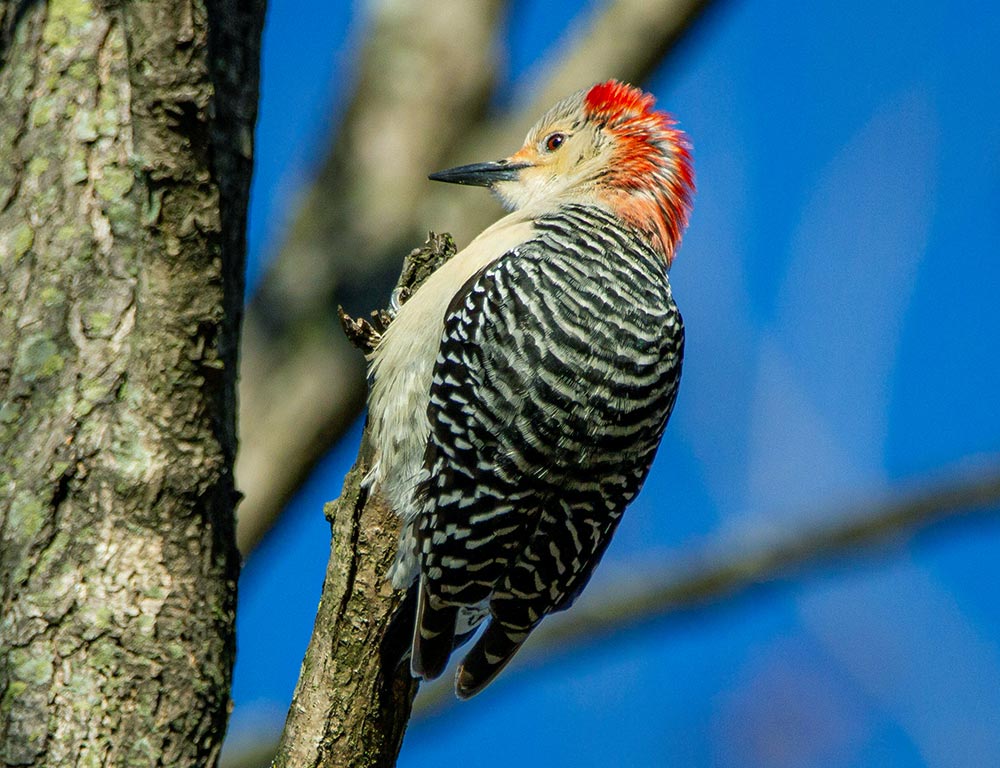
- Scientific Name: Melanerpes carolinus
- Population: Abundant and widespread
- Life Span: Up to 9 years in the wild
- Size: 9-10.5 inches in length
- Weight: Approximately 2-3 ounces
- Food: Insects, fruits, nuts, and seeds
- Status: Least Concern (population stable)
Despite its name, the Red-bellied Woodpecker usually has only a faint red wash on its belly. Its vibrant head and distinctive zebra-striped back make it a familiar sight in Missouri’s woodlands and suburban areas.
With strong bills designed for drilling, Red-bellied Woodpeckers forage for insects, fruits, nuts, and seeds. They are known for their adaptive behavior, readily utilizing bird feeders in residential areas.
Their territorial calls and drumming sounds contribute to the auditory richness of the forest. Nesting in tree cavities, these woodpeckers are adaptable, often reusing old nesting sites or selecting new ones.
Conservation efforts focus on preserving mature woodlands and providing suitable habitats for cavity-nesting birds like the Red-bellied Woodpecker.
5. Yellow-bellied Sapsucker
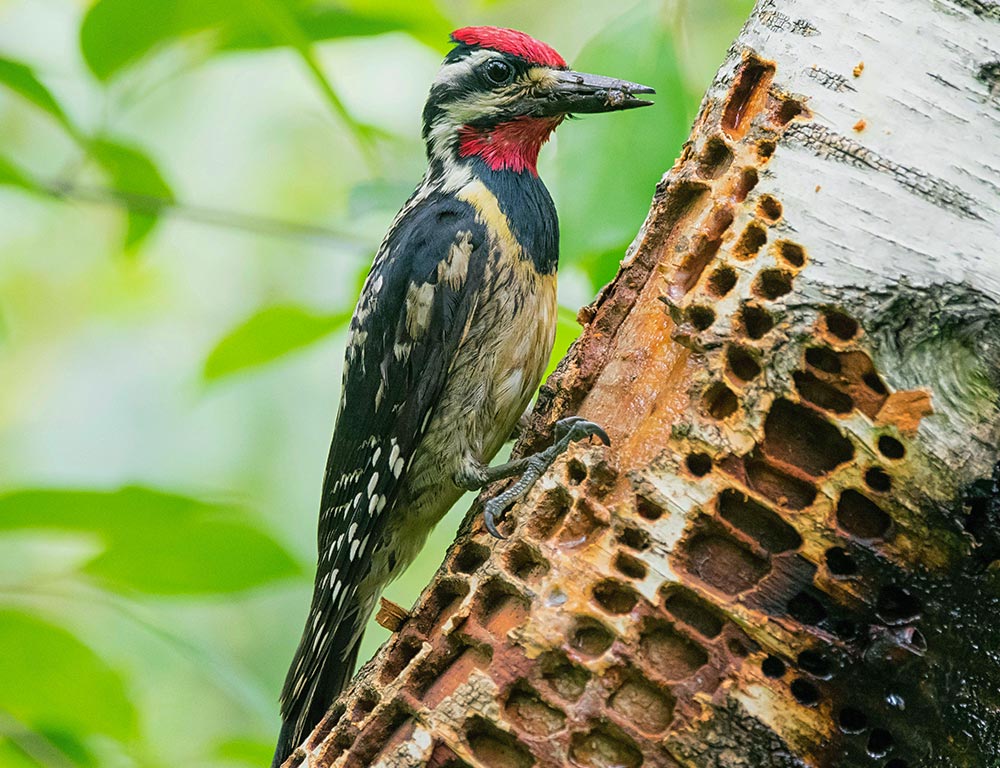
- Scientific Name: Sphyrapicus varius
- Population: Generally stable, but populations can be impacted by habitat changes
- Life Span: Up to 9 years in the wild
- Size: 7.5-8.5 inches in length
- Weight: Approximately 1.5-2.5 ounces
- Food: Sap, insects, and tree saplings
- Status: Least Concern (population stable)
The Yellow-bellied Sapsucker is a migratory woodpecker who occasionally visits Missouri during migration. Its unique feeding behavior drills rows of small holes in tree bark to feed on sap.
These sapsucker wells also attract insects, providing an additional food source. Despite its name, the yellow wash on its belly is often challenging to see.
Yellow-bellied Sapsuckers have a distinctive drumming pattern and mewing call. During the breeding season, they excavate nest cavities in trees, particularly favoring dead or weakened trees.
Conservation efforts aim to ensure the availability of diverse forest habitats, including both mature and dead-standing trees, to support the migratory patterns and nesting needs of the Yellow-bellied Sapsucker.
6. Northern Flicker
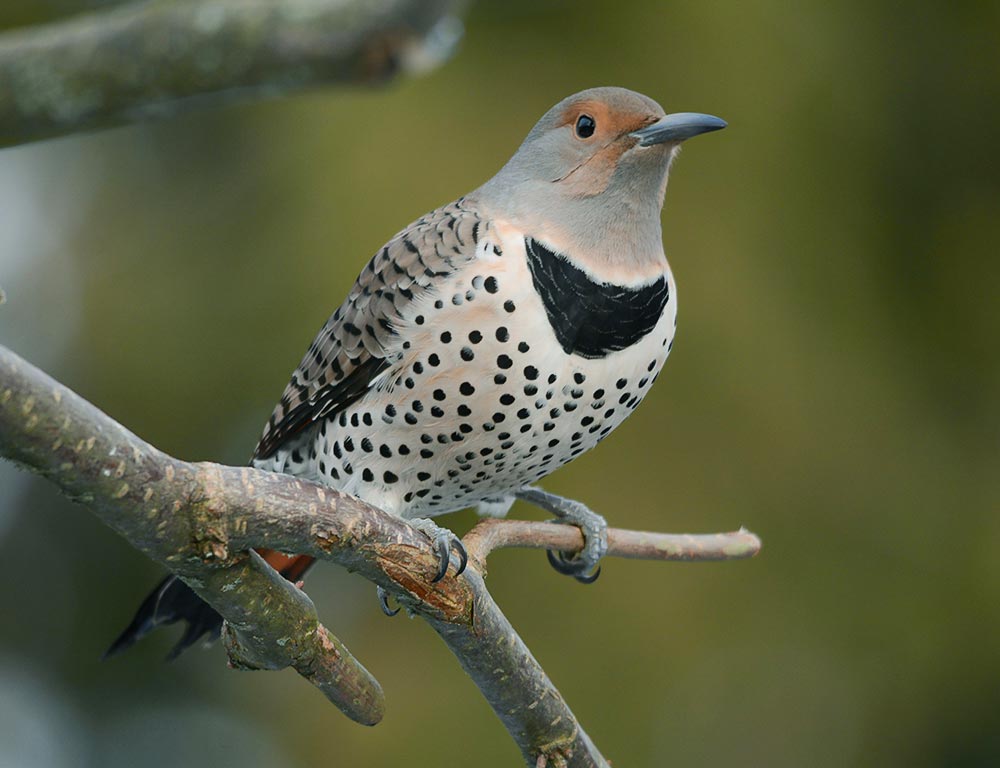
- Scientific Name: Colaptes auratus
- Population: Abundant and widespread
- Life Span: Up to 9 years in the wild
- Size: 11-14 inches in length
- Weight: Approximately 3-5 ounces
- Food: Insects, fruits, seeds, and ants
- Status: Least Concern (population stable)
The Northern Flicker, with its distinctive plumage featuring a spotted belly and a crescent on the chest, is a common and adaptable woodpecker species in Missouri.
Unlike many woodpeckers, flickers often forage on the ground for ants and other insects. Their strong bills are well-suited for drilling into the soil or tree bark. Northern Flickers also consume fruits and seeds, showcasing their dietary versatility.
Their drumming sounds and loud calls are notable in open woodlands and suburban areas. Northern Flickers nest in tree cavities or use abandoned nests of other birds.
Conservation efforts emphasize maintaining a mix of open and wooded habitats to support the diverse foraging and nesting needs of Northern Flickers in Missouri’s landscapes.
7. Lewis’s Woodpecker
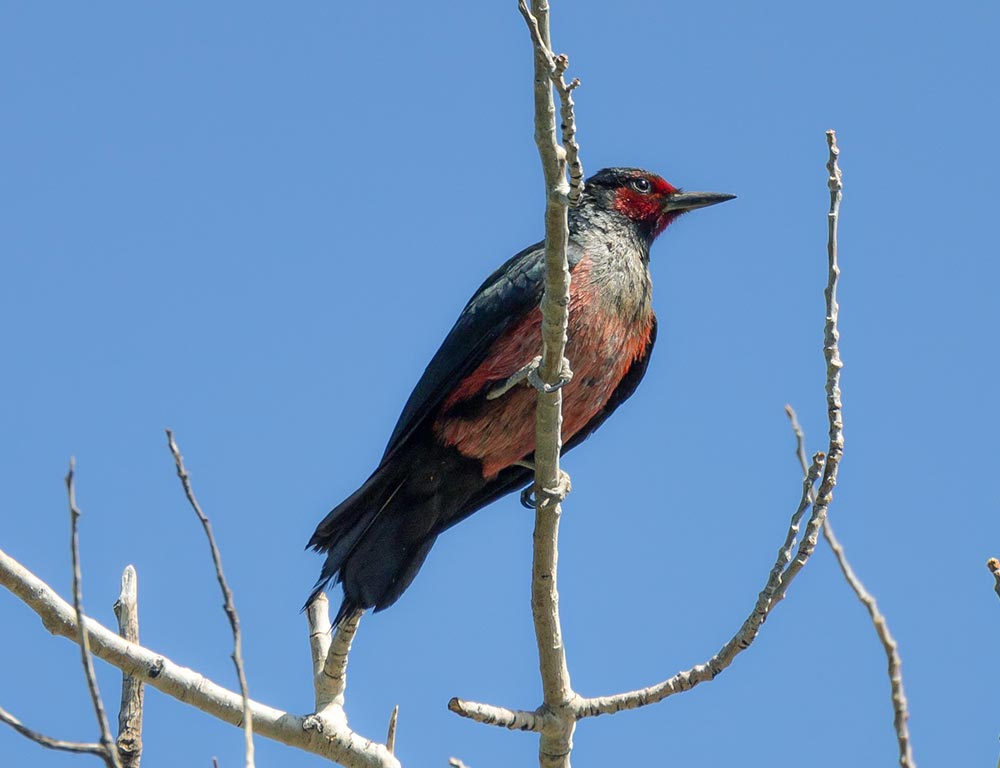
- Scientific Name: Melanerpes lewis
- Population: Generally stable but can be impacted by habitat loss
- Life Span: Up to 8 years in the wild
- Size: 10-11 inches in length
- Weight: Approximately 3-5 ounces
- Food: Insects, fruits, and nuts
- Status: Least Concern (population stable)
Lewis’s Woodpecker is a distinctive species known for its unique appearance and foraging behavior. It stands out among woodpeckers with a dark, glossy green-black plumage and a pinkish-red belly.
Unlike typical woodpeckers, Lewis’s Woodpeckers catch insects in mid-air and are known to eat fruits and nuts.
They are often observed perching on dead trees or poles, scanning the surroundings for flying insects. Nesting in tree cavities, they lay their eggs in decaying wood.
Conservation efforts focus on maintaining open habitats with suitable nesting sites, preserving snags for roosting, and minimizing habitat fragmentation to ensure the continued success of Lewis’s Woodpecker populations.
8. Red-cockaded Woodpecker
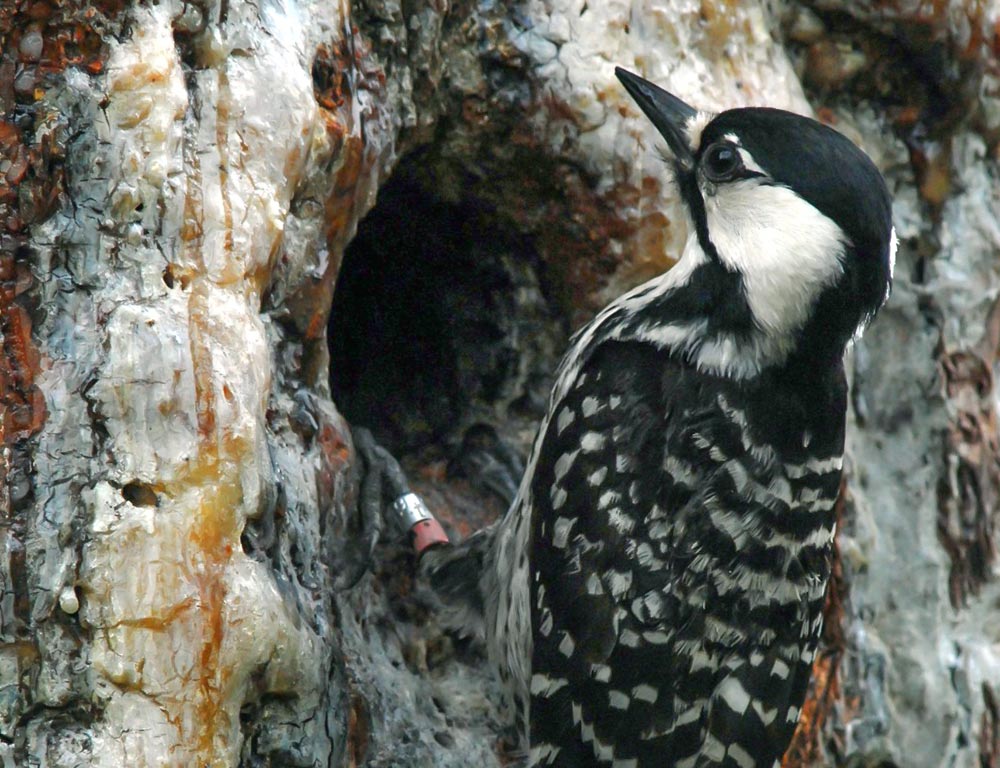
- Scientific Name: Dryobates borealis
- Population: Declining, listed as Near Threatened
- Life Span: Up to 15 years in the wild
- Size: 8-9 inches in length
- Weight: Approximately 1.5-2.5 ounces
- Food: Insects, especially ants
- Status: Near Threatened (population decreasing)
The Red-cockaded Woodpecker is a southern pine forest specialist known for its cooperative breeding behavior and reliance on mature pine ecosystems.
Recognized by small black caps and distinctive black and white plumage, they have a unique habit of excavating cavities exclusively in live pine trees. These woodpeckers primarily feed on ants, showcasing a specialized diet.
Red-cockaded Woodpeckers face challenges due to habitat loss, particularly the reduction of mature pine forests and the spread of fire-suppression practices.
Conservation efforts involve habitat restoration, controlled burns to maintain open pine ecosystems, and artificial cavity installations to support their nesting needs.
Despite ongoing conservation measures, the Red-cockaded Woodpecker remains listed as Near Threatened due to habitat fragmentation and loss.
Where to Spot Woodpeckers in Missouri?
Missouri is home to several species of woodpeckers, and they can be found in various habitats across the state. Here are some places where you might spot woodpeckers in Missouri:
State Parks and Conservation Areas
Many state parks and conservation areas in Missouri provide suitable habitats for woodpeckers. Consider visiting places like Mark Twain National Forest, Katy Trail State Park, and Cuivre River State Park.
Forested Areas
Woodpeckers are often found in wooded and forested areas. Explore places with mature trees like the Ozark and St. Francois Mountains regions.
Missouri River Valley
The Missouri River Valley and its surrounding areas can be good locations for woodpecker sightings. The mix of woodlands and water sources can attract various bird species.
Wildlife Management Areas
Check out wildlife management areas, such as Four Rivers Conservation Area and Fountain Grove Conservation Area, which may have suitable habitats for woodpeckers.
Nature Reserves
Nature reserves and wildlife refuges, like Clarence Cannon National Wildlife Refuge or Great River National Wildlife Refuge, can be excellent places to observe woodpeckers in their natural habitats.
Birding Hotspots
Consult local birding resources and websites that highlight popular birding locations. Some areas may be well-known for attracting various bird species, including woodpeckers.
Backyard Birdwatching
Woodpeckers can also be spotted in residential areas, especially if there are mature trees. Consider setting up bird feeders with suet, which is a favorite food for many woodpecker species.
Seasonal Migration
Keep in mind that woodpecker activity may vary depending on the season. Some species are more active during certain times of the year, such as spring and fall.
Common woodpecker species in Missouri include the Pileated Woodpecker, Red-bellied Woodpecker, Downy Woodpecker, Hairy Woodpecker, and Northern Flicker.
Patience and keen observation are key when birdwatching, so be prepared to spend some time in nature to increase your chances of spotting woodpeckers.
Wrapping Up
In concluding our exploration of the eight woodpecker species in Missouri, we find these charismatic birds bring rhythmic melodies to the state’s woodlands and serve as ecological architects.
Each species contributes uniquely to Missouri’s ecosystems, from the bold Pileated Woodpecker to the intricate Northern Flicker.
Their role in insect control and habitat modification underscores their importance in maintaining a balanced and healthy environment.
As we marvel at their distinctive characteristics and behaviors, let us appreciate the intricate role woodpeckers play in shaping Missouri’s natural tapestry and enhancing the overall biodiversity of the region.